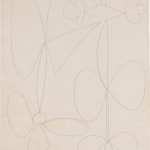Pablo Picasso Spanish, 1881-1973
64.8 x 50.5 cm
Gilot returned to the studio many times, eventually alone, to see Picasso's work, which was banned for exhibition under the Nazi occupation. By 1946, she was living with Picasso at the rue des Grands-Augustins. In February of that year, he took her to visit Henri Matisse in Vence, where Matisse took an instant liking to her and remarked that he would like to depict Gilot with green hair.
This did not please the jealous Picasso and once the couple arrived back in Paris, he immediately embarked on his seminal portrait of her, La Femme-fleur (1946). He described Gilot as "a growing plant," compelled to depict her as part of the 'vegetable kingdom' rather than the animal kingdom. In the portrait, Gilot's moon-like blue face emerges from delicate leaves and tendrils, her body nothing more than a stalk. This palette of blues and greens would become a signature in Picasso's images of Gilot, a theme that carried through all his depictions of the various women in his life. Each woman had her own symbolism and a unique language to their portraits.
Picasso and Gilot moved to Vallauris in the Provence-Alples-Côtes d'Azur region of France in May 1948. In a period of boredom and restlessness, Picasso turned his hand to making ceramics, experimenting with forms and color and producing works that are now much celebrated. Vallauris was famed for its red clay and had boomed due to metal shortages during the war, but business faded after liberation. Picasso would change all of that, and the village remains a destination because of his time there.
These post-wars years marked an unusual period of blissful domesticity for Picasso. His first child with Gilot, Claude, was born in May 1947 and by the fall of 1948, Gilot was carrying their second child, Paloma. During this time, Picasso returned to the flower imagery he associated with Gilot, making two drawings, including the present work, on 28 September 1948. A few days later, he would return to this theme, drawing at least four more variations of flowers and the femme-fleur imagery Gilot inspired in him, perhaps inspired by her advancing pregnancy.
The engaging, anthropomorphic still life in Fleurs seems to suggest a portrait of Picasso and Gilot, with the silhouette of the male and female plants facing each other in a conversant posture. The fluid decorative line of the drawing, reduced means and simplified composition is also suggestive of Picasso’s continuing dialogue with the artist Henri Matisse. During this time, after the meeting of Gilot and Matisse that provoked such jealousy, the two artists lived near each other in the South of France and were intensely aware of each other’s artistic investigations and innovations.
Provenance
Galerie Louise Leiris, Paris
Private Collection, Spain (acquired from the above)
Sotheby's London, 26 June 2008, lot 199 (consigned by the above)
Private Collection, London (acquired at the above sale)
Acquired by the previous owner from the above
Literature
Christian Zervos, Pablo Picasso, Oeuvres de 1946 a 1953, vol. XV, Paris, 1965, no. 83, pl. 50, illustratedThe Picasso Project, ed., Picasso's Paintings, Watercolors, Drawings and Sculpture. Liberation and Post-War Years, 1944-1949, San Francisco, 2000, p. 199, no. 48-017 (illustrated)









